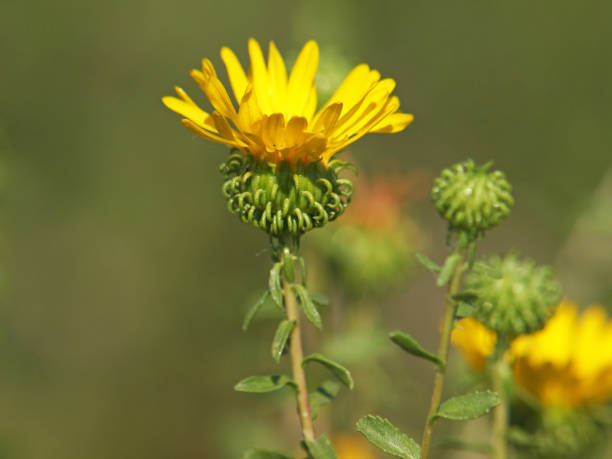
Great valley gumweed
Grindelia camporum
Grindelia camporum, or Great Valley gumplant, is a resinous perennial herb native to California, known for its sticky, bright yellow daisy-like flowers and aromatic, toothed leaves. It typically grows in grasslands and open habitats, attracting a variety of pollinators while tolerating drought and poor soils.
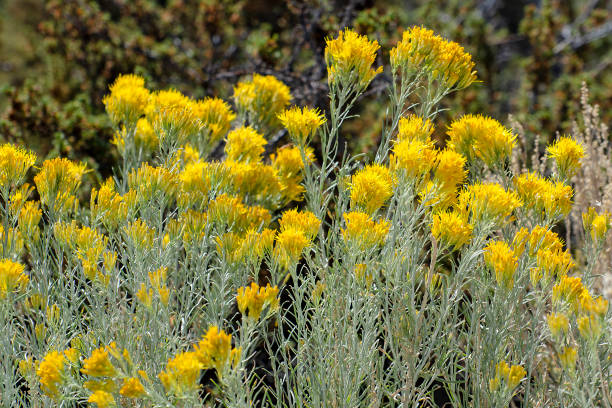
Rubber rabbitbrush
Ericameria nauseosa
Ericameria nauseosa, commonly known as rubber rabbitbrush, is a drought-tolerant shrub native to arid regions of western North America, recognized for its silvery-green, narrow leaves and bright yellow flower clusters that bloom in late summer to fall. It thrives in disturbed soils and plays an important ecological role in erosion control and pollinator support.

Creosote bush
Larrea tridentata
hardy evergreen shrub native to the arid regions of the southwestern United States and northern Mexico. It thrives in desert environments, particularly in the Mojave, Sonoran, and Chihuahuan Deserts. The plant is known for its small, waxy leaves and distinctive yellow flowers, as well as its strong, tar-like scent—especially after rain. Larrea tridentata plays an ecological role by stabilizing soil and providing shelter and food for various desert organisms.

Coastal redwood
Sequoia sempervirens
The coastal redwood is one of the most unique plants in California! It is an evergreen tree that can live to be around 2,200 years old or more. These trees can grow to be 379 feet and have a diameter of 26 feet. It best lives in coastal California and Oregon where the winters are cool and the summers are foggy. For their impressive size their cones are quite small.
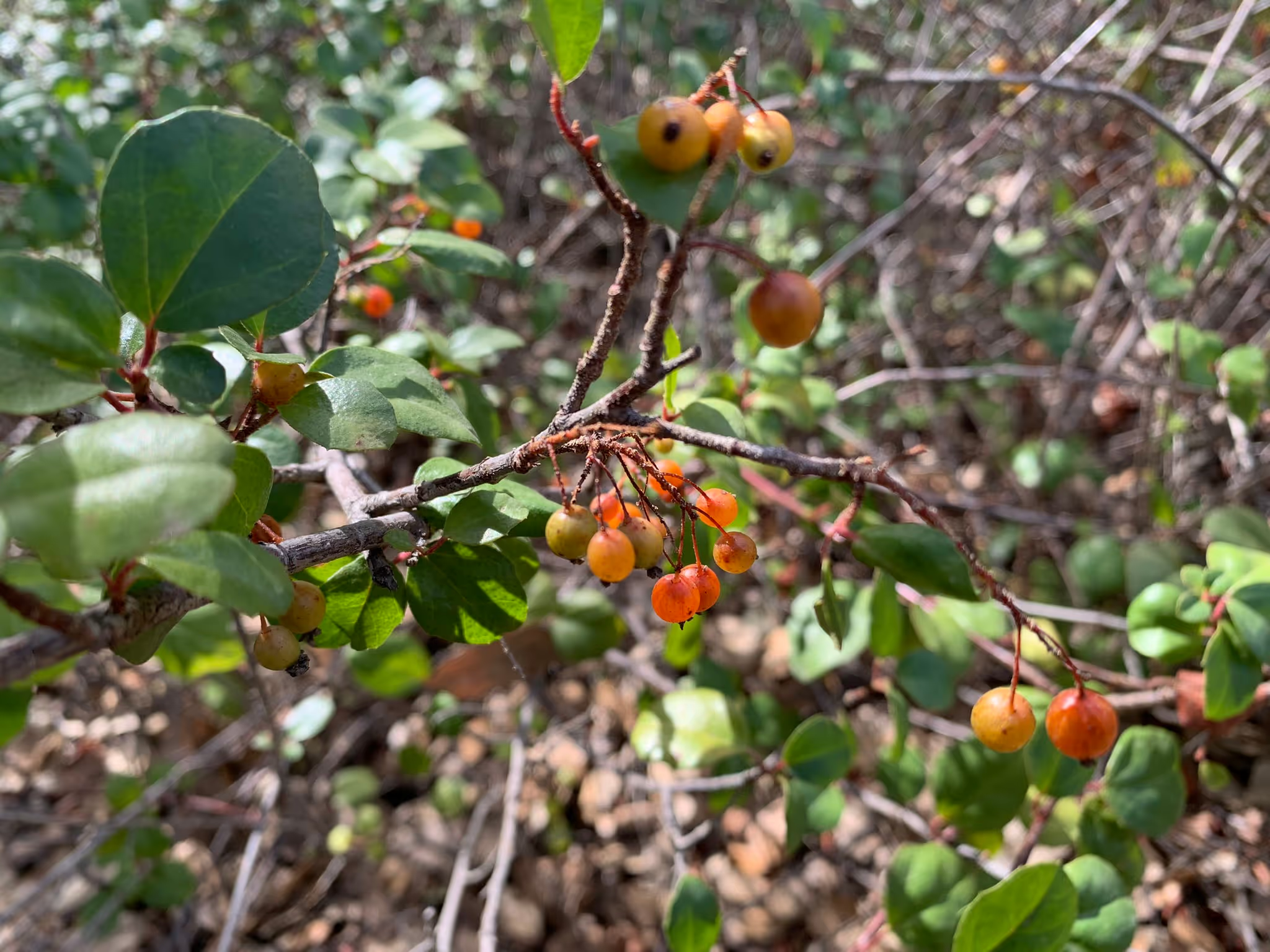
Santa Catalina Island Currant
Ribes viburnifolium
Santa Catalina Island currant is a rare plant known from Santa Catalina Island, the southernmost parts of San Diego County, and Baja California. This currant is a common groundcover in shady areas of the garden. While the leaves of most currants are deciduous, this species has evergreen leaves making it suitable for gardeners who prefer not to have dormant, leafless plants in their garden part of the year. Its fruits start off green to orange and finally red when fully ripened.

Davidson's buckwheat
Eriogonum davidsonii
Davidson's buckwheat is mostly native to southwestern California and Baja California. It is an annual that likes to grow on sandy or gravelly soils in a wide range of habitats. This buckwheat's leaves are only found on the base of the plant and will lose its leaves as temperatures rise to conserve water loss, mainly photosynthesizing through its stems. Most of Davidson's buckwheat is composed of branching stems that have flower clusters widely-spaced apart from each other. The flowers are small, about 2 millimeters wide, and range from whitish to pinkish.

Tornleaf Goldeneye
Senecio flaccidus
This plant from the sunflower family is a shrub native to coastal southern California and northern Baja. It is part of the chaparral and coastal sage scrub communities, living on dry mesas, canyons, and slopes. The showy yellow flowers of this plant can be seen most of the year.
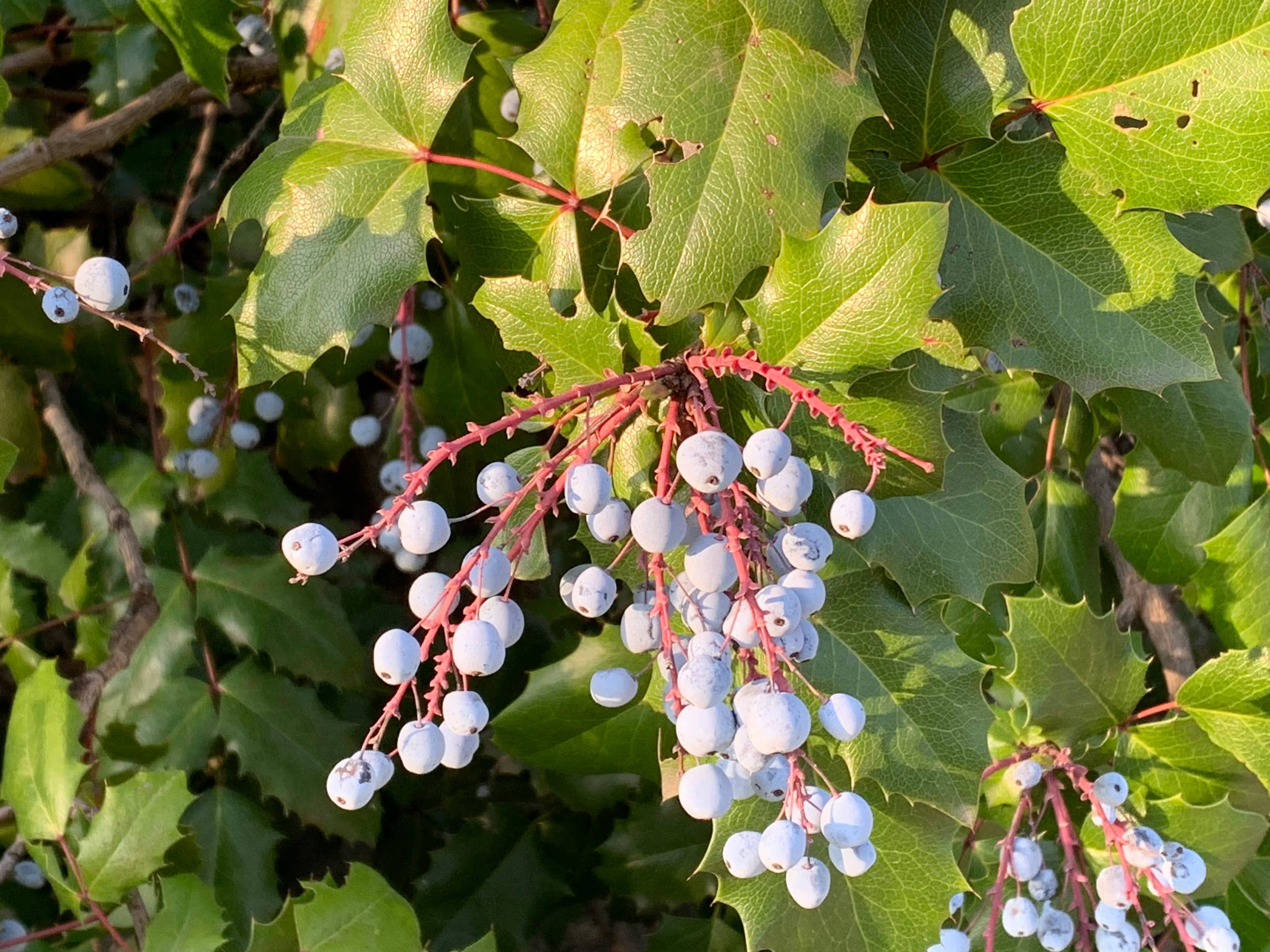
Oregon Grape
Berberis aquifolium
During the summer it produces blue berries that look like grapes - giving it the namesake Oregon Grape! While it looks like a grape, it is actually a barberry. It likes to grow in the mountains and foothills throughout California.
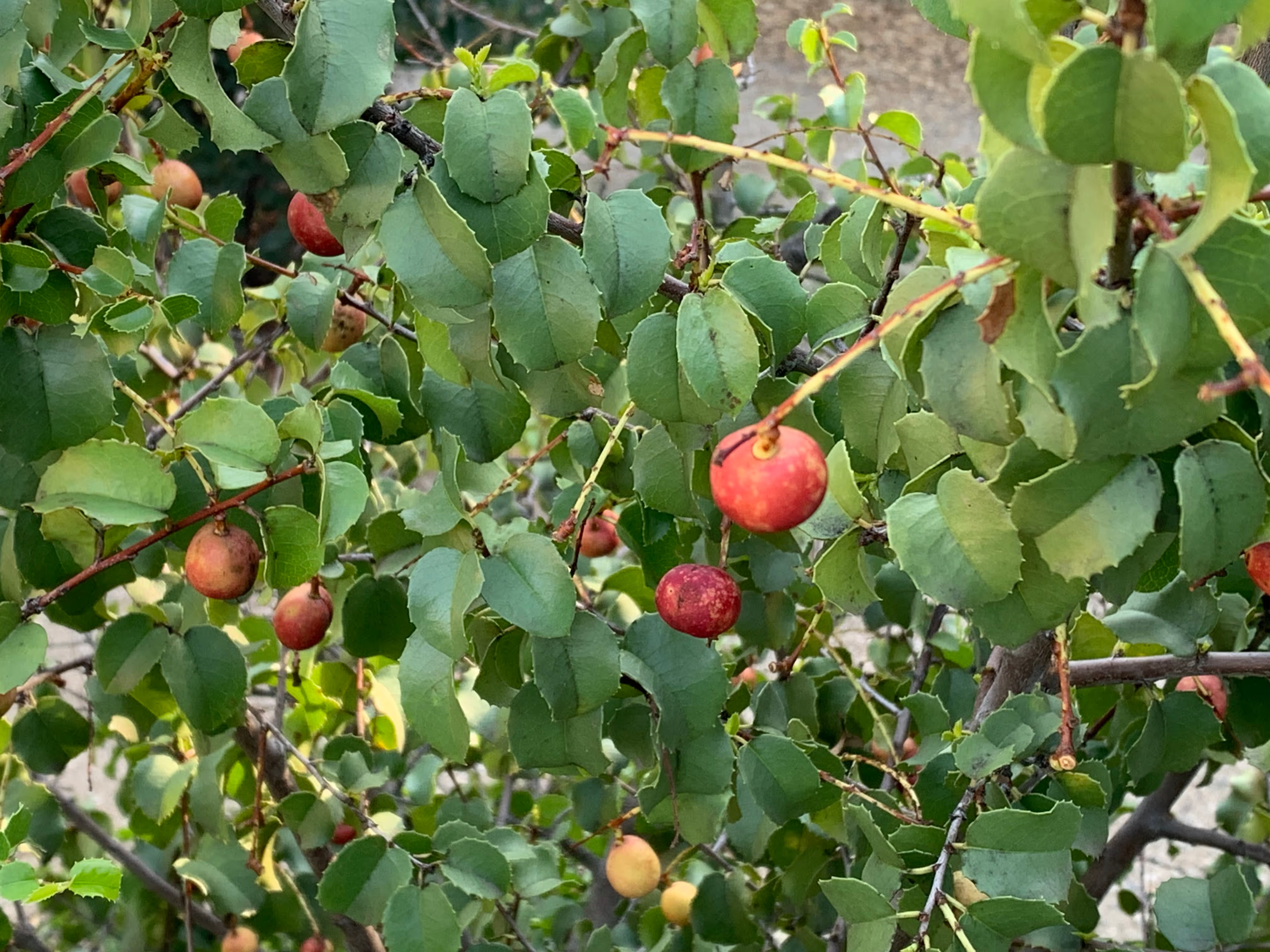
Hollyleaf Cherry
Prunus ilicifolia
This evergreen species in the Rose family is native to coastal California and northern Baja California. It produces red fruits, cherries, in the late summer which birds love. This species has two varieties and the spiky leaves give away that is mainland variety.
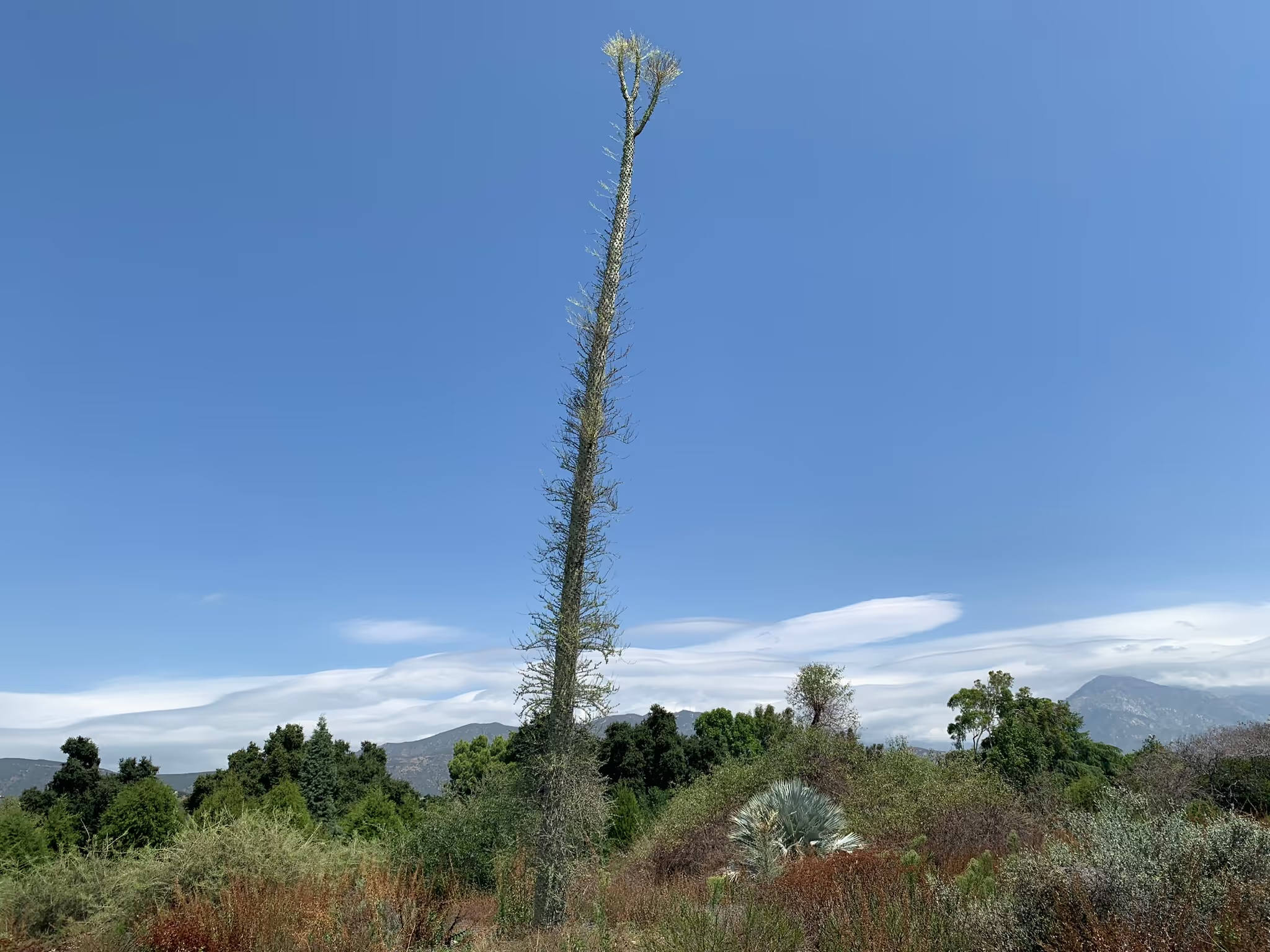
Boojum tree
Fouquieria columnaris
The boojum tree is often considered to be the strangest tree on Earth which is native to Baja California and part of the Sonoran desert. It has a single conical stem with numerous small twigs around the whole tree. While it can live for centuries, it grows very slowly and can take 10 to 20 years to reach one foot in height. The boojum tree usually loses its leaves in drought and develops more when it starts to rain. In late summer, it develops yellow tubular flowers towards the top of the tree which attract insects and birds.

Goldenrod
Solidago velutina ssp. californica
There are many species of goldenrod but this is main one found in the gardens. Goldenrods are in the sunflower family (Asteraceae). This native species grows throughout California, mostly in open, grassy places in elevations between 0 to 7500 feet above sea level. It loves to flower around the time when most plants don't so it's great for birds and insects. True to the name, the numerous golden yellow flowers densely cover the tops of the plant when in flower.
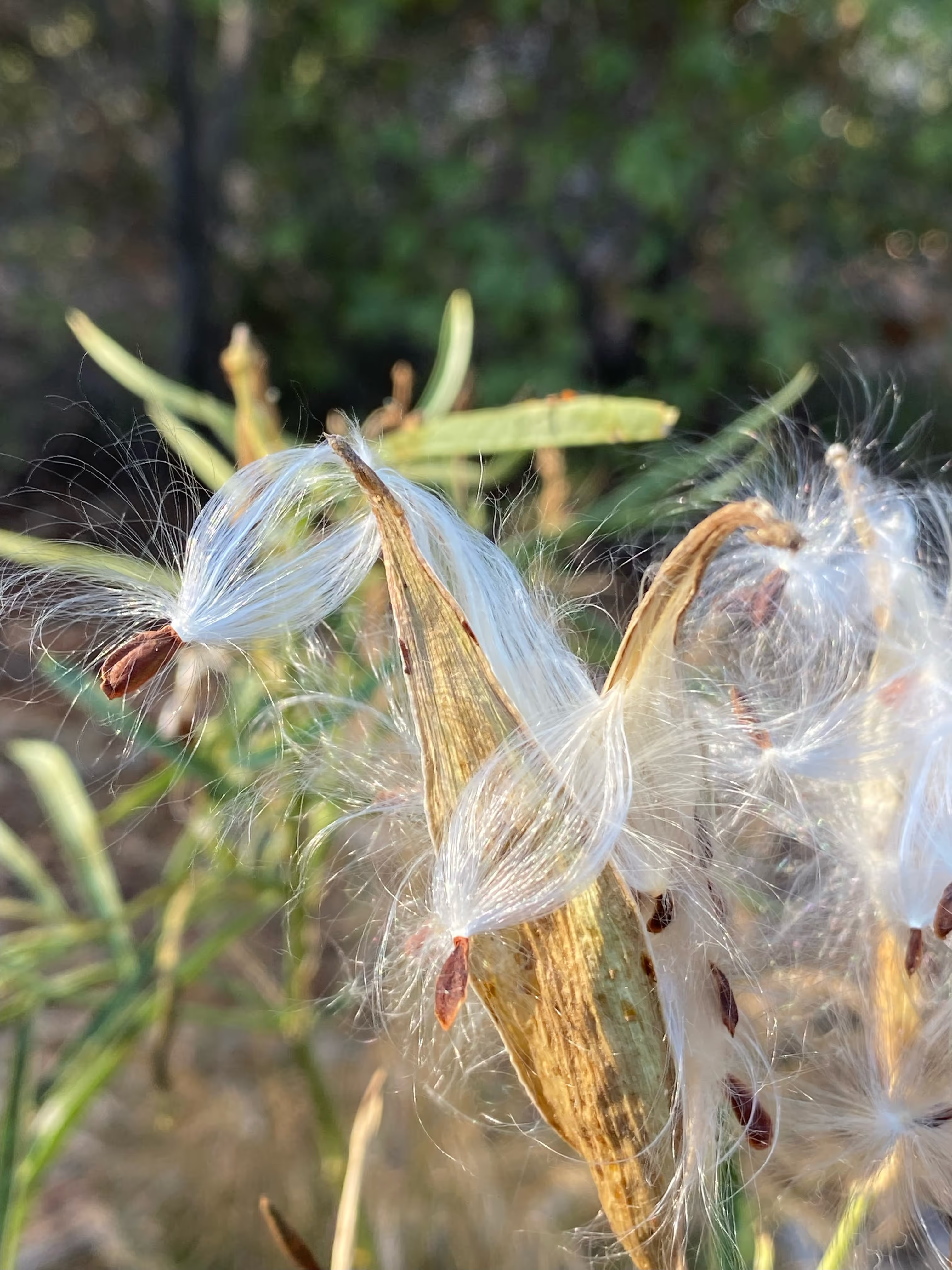
Narrow leaf milkweed
Asclepias fascicularis
Fruit of the narrow milkweed! When the fruit matures, it splits open and releases its seeds. The seeds are attached to hairs, called floss, that help the seeds get dispersed by the wind. These flowering perennials stand up tall and slender with their long narrow leaves that whorl around their stems.

Spreading Rush
Juncus patens
It is native to the West Coast of the United States from Washington to California, and into Baja California, Mexico.

Emory's crucifixion- thorn
Castela emoryi
This glorious plant is native to the Mojave and Sonoran deserts. It does really well in the peak heat of summer and is known for its leafless and sharp branches. It is used medicinally for skin remedies by the Yavapai tribe.

California juniper
Juniperus californica
A cypress tree with juniper "berries"!

Apache plume
Fallugia paradoxa
A rose-relative native to the desert with white flowers and very unique, wispy fruits. These fruits have pinkish feathery styles that disperses with the wind. While found outside California, inside the state it is restricted to north of and within the Mojave National Preserve.

Chaparral beardtongue
Keckiella antirrhinoides
These yellow-flowered shrubs can be found in many places throughout CalBG, as well as coastal mountains in Orange, Riverside and San Diego counties.

California primrose
Oenothera californica
Grows low to the ground and has showy white flowers that turn pink with age. It's native to the southwestern US and Baja California, found in chaparral, higher elevation deserts and woodlands. It prefers to grow in sandy or gravely soils.

Mojave yucca
Yucca schidigera
This relative of the Joshua tree has very similar large, white flowers that are pollinated at night by yucca moths.

Rush milkweed
Asclepias subulata
Rush milkweed grows in the deserts of California and, like other milkweeds, is a host plant for the monarch butterfly. This plant has very narrow leaves that are only present part of the year. It does much of its photosynthesis via its green stems.
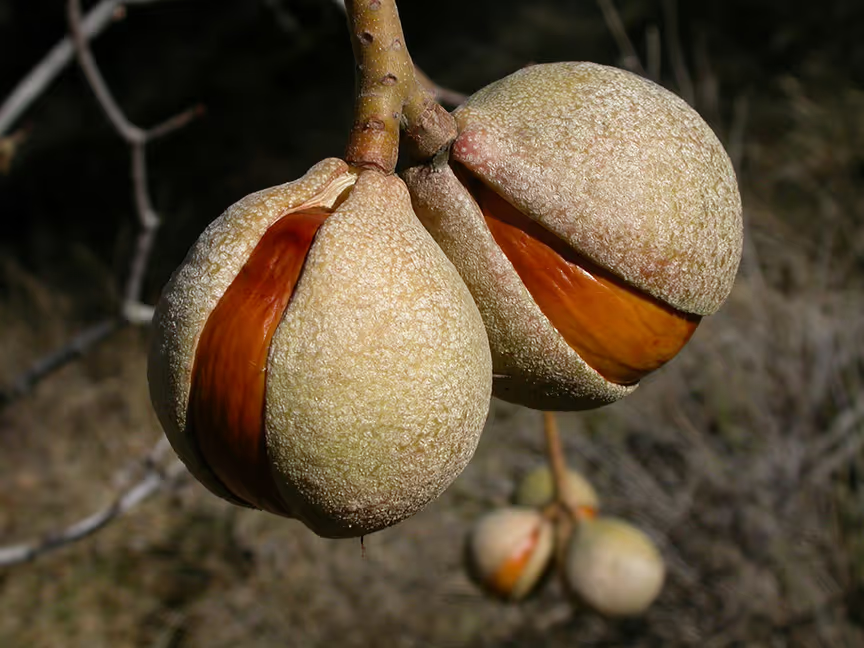
California buckeye
Aesculus californica
What's that tree with no leaves that is covered in big fruits? That's the summer-deciduous California buckeye. While the large nuts of this plant are enjoyed by squirrels at the Garden, they are toxic to people. They have been used medicinally and as food in the past but leaching out the toxins and rendering them safe to consume is a very labor-intensive process.

Telegraph Weed
Heterotheca grandiflora
Despite the common name, telegraph weed is a native wildflower in California. "Weed" is an arbitrary term used for plants that are unwanted in an area. In a garden of cultivated plants, telegraph weed may legitimately be considered a weed, but in the wilds of California, it is an important part of the ecosystem. It is, however, an invasive weed in wildlands of Australia where it has been introduced.
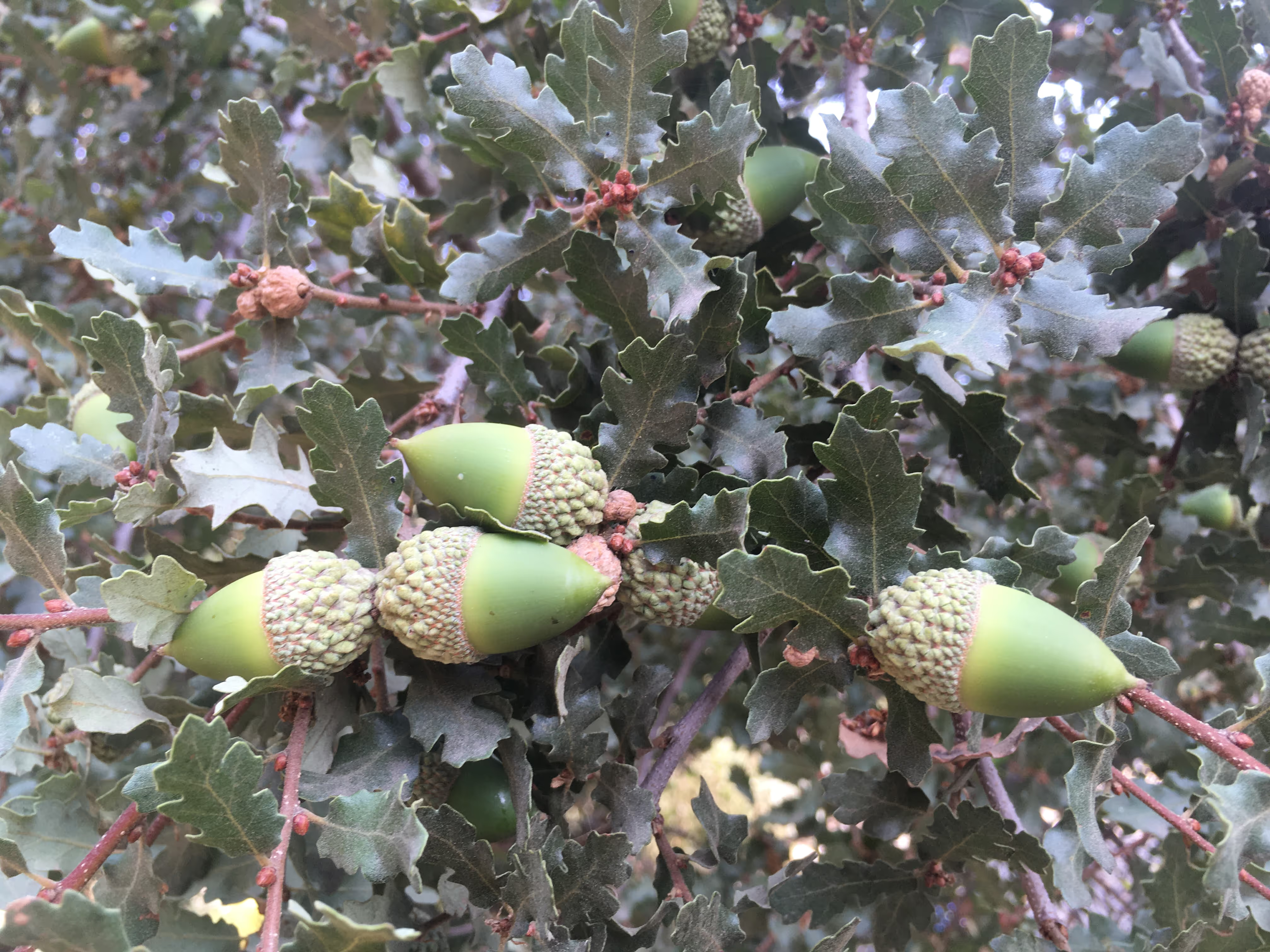
Oak
Quercus spp.
There are 18 species of oaks growing in the garden. The fruit of an oak is called an acorn, which you'll likely see squirrels and maybe woodpeckers collecting and storing. In some years an oak will produce a huge number of acorns relative to other years. This is called masting. Years of very high acorn production overwhelm the animals that would eat them, so many of the acorns the animals store in those years are not eaten and have a chance to grow into new trees and shrubs.
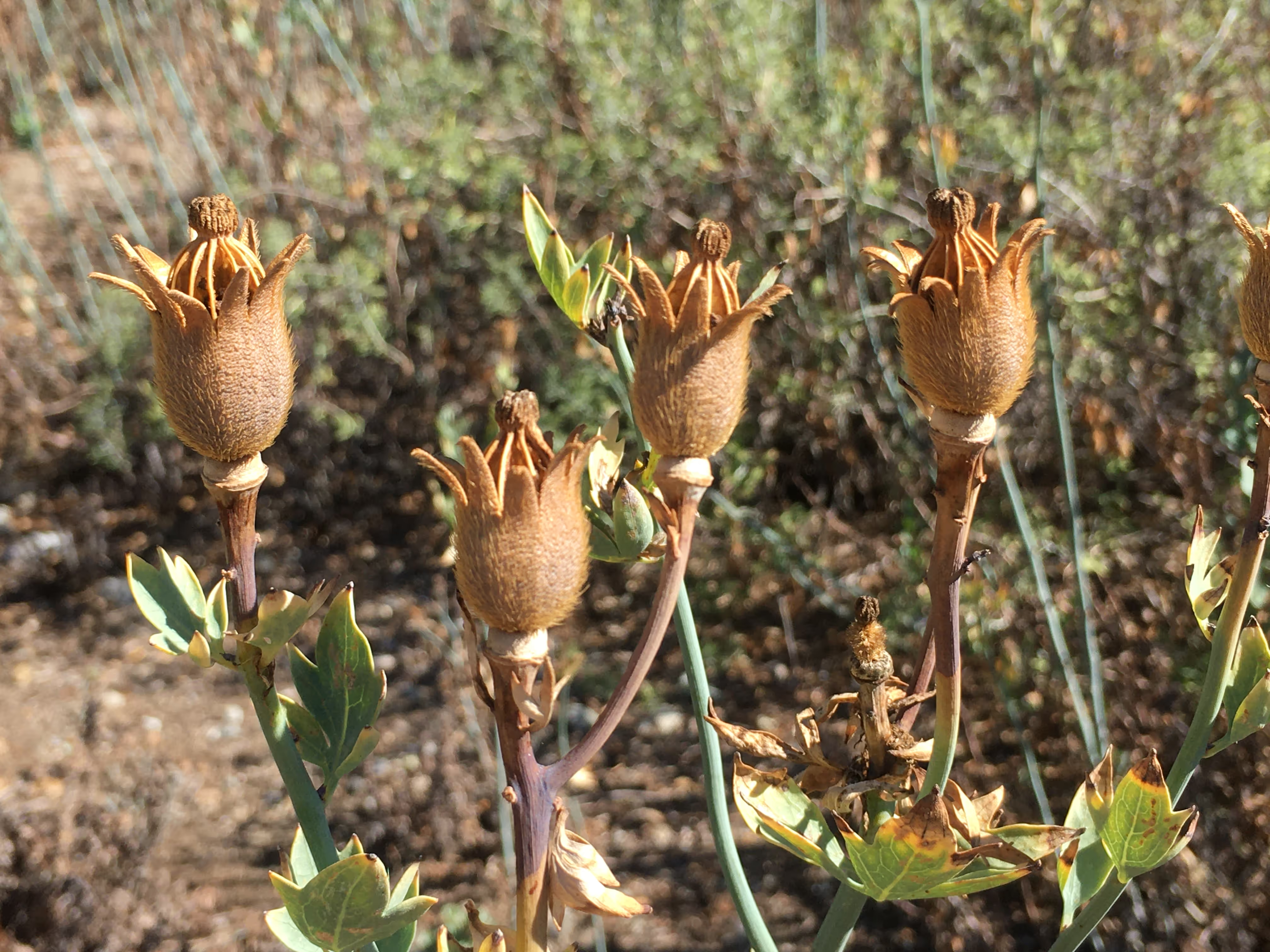
Matilija Poppy
Romneya spp.
The two species of Matilija poppies are generally known for having the largest flowers in California. Their beauty doesn't stop there though. Once done flowering, the fruits dry out and valves open from the top to allow seeds to fall out. These strange fruits are definitely a garden highlight in the fall.
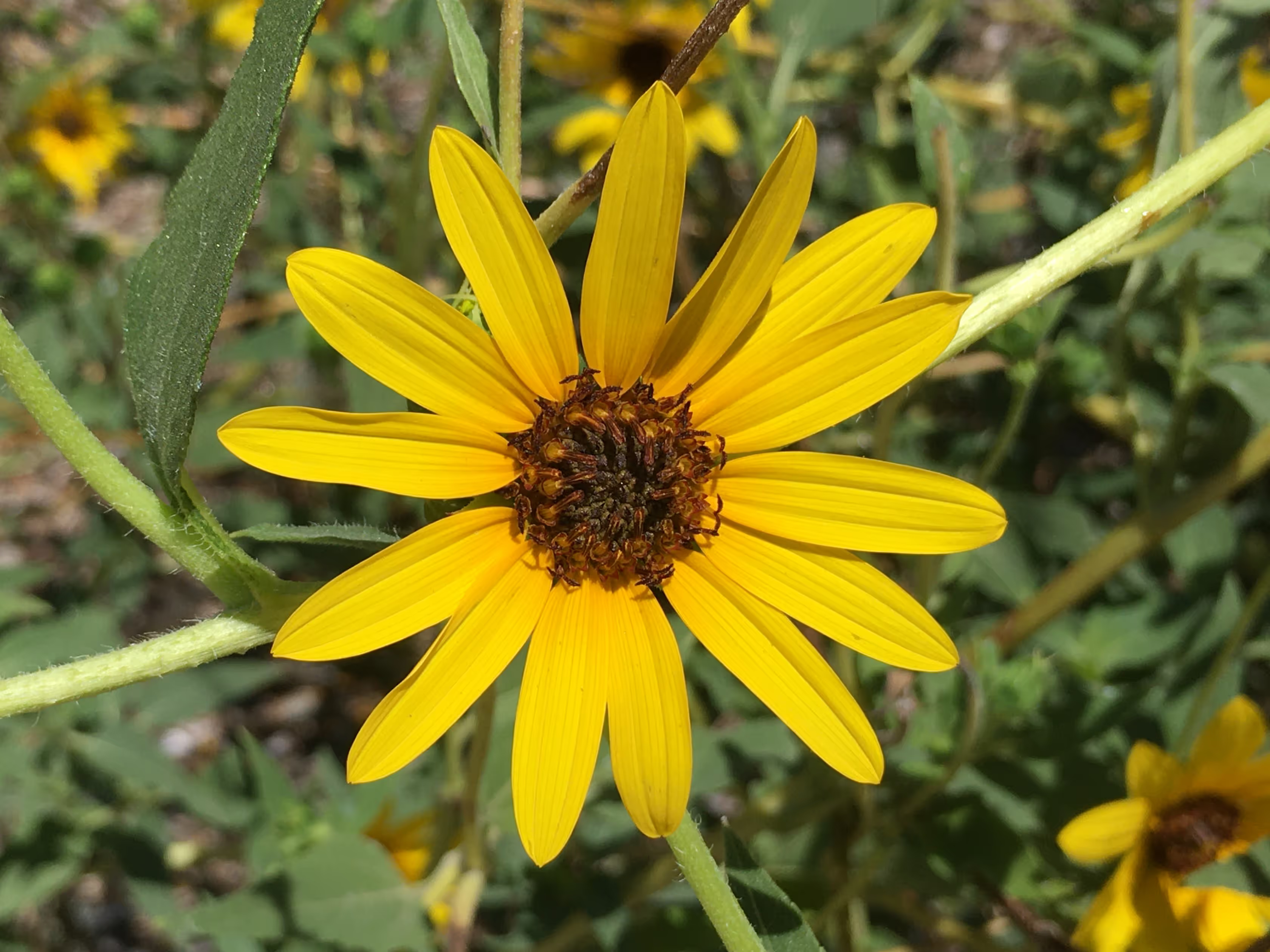
Common sunflower
Helianthus annuus
Common sunflowers are the tall plants with yellow flowers that greet you in the Wildflower Meadow when you first step into the garden. This species is native to much of North America where it has been cultivated by Indigenous Americans for thousands of years. The sunflowers you grow with giant flowers are this same species but selectively bred for bigger flowers and thus the bigger, tasty sunflower seeds you eat.

Birch-leaf Mountain-mahogany
Cercocarpus betuloides
The genus name Cercocarpus means tailed-fruit, which you can see in the photo is an appropriate name for this plant. The hairs on the tail help the fruit better catch the wind and blow it to new locations. The tail curls when dry and uncurls when moist. This change between curled and uncurled can actually drill the seed into the soil where it may grow to become a new shrub.

California Wild Grape
Vitis californica
Immediately recognizable, the California wild grape is a vine with leaves that turn red, orange, or yellow in the fall, small yellow-green clusters of fuzzy flowers, and purple grapes. It grows mainly in Central or Northern California where there is more water, but can grow in damp areas here in Southern California. This plant is really drought tolerant though, and its grapes serve as food for humans and small animals. A yellow dye can also be made from its leaves.

Sticky Monkeyflower
Diplacus aurantiacus
The sticky monkeyflowers are the only shrubby monkeyflowers in California and named for the often sticky leaves. These species have a wide variety of flower colors that are made even wider by cultivated hybrids. The garden has a nice sampling of both native species and cultivars derived from them. The most common color you'll see is orange but you can find flowers that are red or yellow. Try looking for them on the western portion of the loop trail in the CA plant communities garden.

Joshua tree
Yucca brevifolia
The Joshua tree is an iconic member of the southern California flora. If you can't make it out to the desert, our garden is a perfect place to see these majestic plants! There are some particularly interesting examples in the California Habitats section of the garden.

Mexican Blue Fan Palm
Brahea armata
Did you know that the California Floristic Province also includes part of Baja California in Mexico? Visit the Baja California section of the garden to see these beautiful pale blue palms and other species from the southernmost reaches of the California Floristic Province.

Beavertail Cactus
Opuntia basilaris
The light purple colored pads of this cactus can add a beautiful contrast to the varying shades of greens of most cactus gardens. Come spring, the pops of fluorescent pink blossoms are a stand out sight. Although this prickly-pear cactus tends not to have spines, you still shouldn't touch it as it is covered in glochids. These small barbed bristles can be very irritating and difficult to remove once they have found their way into your skin!

Buckhorn Cholla
Cylindropuntia acanthocarpa var. coloradensis
Standing upright and branching, this cactus is found along rocky slopes of the Mojave and Sonoran Deserts. Its yellow-green stems are covered with straw colored, overlapping spines. Flowering in spring, it will produce flowers that are bright yellow at the center and fade into a rich bronze color at the outer edges.

Pancake Prickly-Pear
Opuntia chlorotica
This spiny cactus gets its name from its round, flat pads, similar to pancakes in shape. Plants tend to be at least as broad as tall, from three to eight feet. Its beautiful yellow blossoms will bloom in May, followed by magenta colored, fleshy fruit. When ripe, the fruit can be picked and used in syrups, candy, jellies and, yes, ice cream! Be cautious when planting near borders as the spines and glochids are sharp and can be difficult to remove!
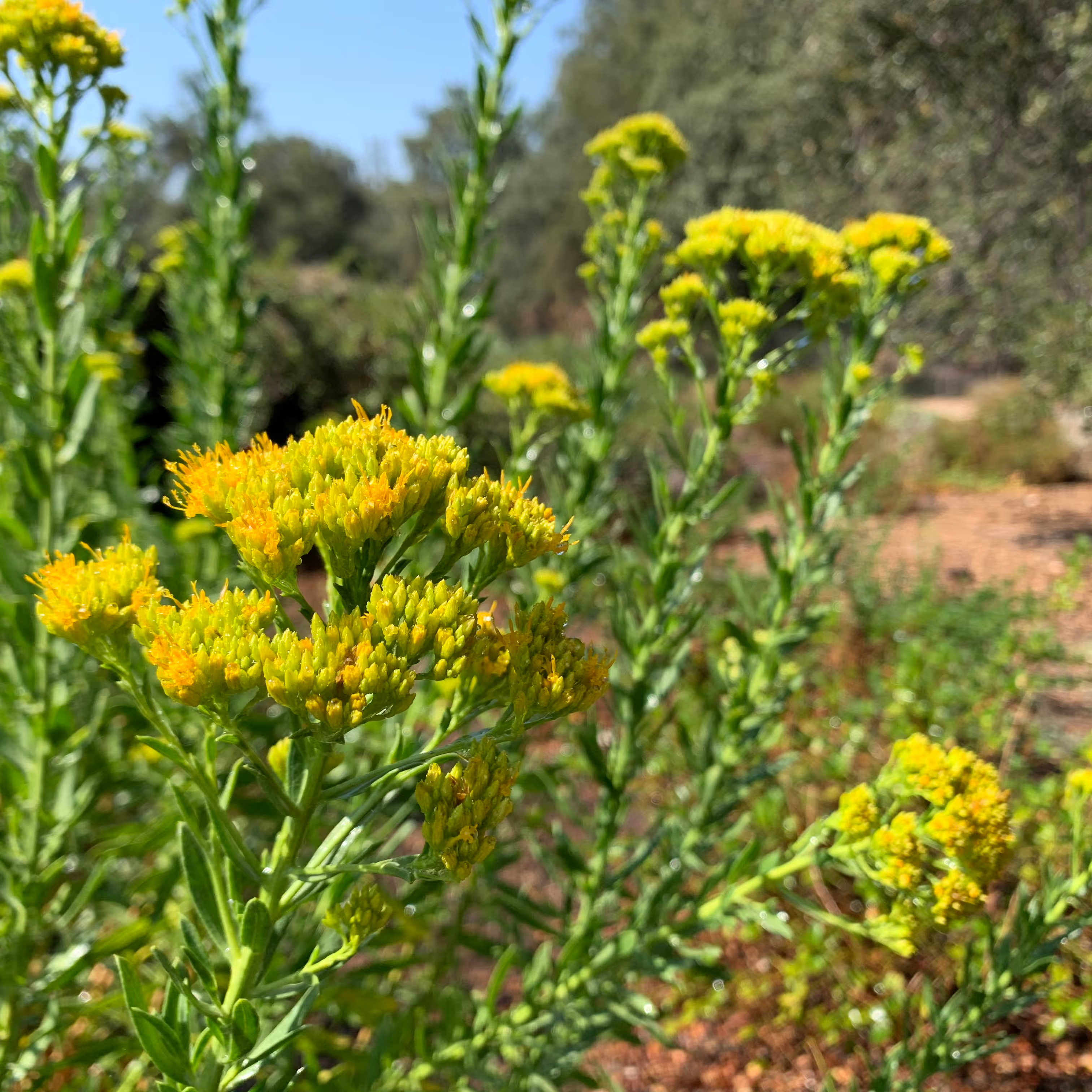
Parish's Rabbitbush
Ericameria parishii
Found in the dry slopes and chaparral throughout Southern California into Baja, this shrub can grow to twelve feet tall. This member of the daisy family has oblong, lime green leaves with a leathery quality. One plant can produce many bright yellow flower clusters, which attract many insect pollinators.

Tall Evening-primrose
Oenothera elata
The bright yellow flowers of the tall evening-primrose contrast beautifully against the plant’s aloe- colored leaves and add beautiful pops of color to the garden. This summer blooming plant will open its flowers in the late afternoon into early evening, and the flowers will then wilt in the heat of the following day. That bright yellow color stands out at night too and provides visual cues to attract a special pollinator in the dim light of the evening, the night flying hawkmoth. The hawkmoth will use its very long tongue to probe into the long floral tube for nectar.

Catalina Island mountain mahogany
Cercocarpus traskiae
Perhaps one of the most endangered trees in all of North America, this beautiful tree is native to Catalina Island. There are only seven known individuals left in the wild! Here at the garden, though, these trees are thriving!

Bindweeds
Calystegia spp.
These vines produce large, magnificent flowers. Typically white, their petals can also be pale purple or blue.
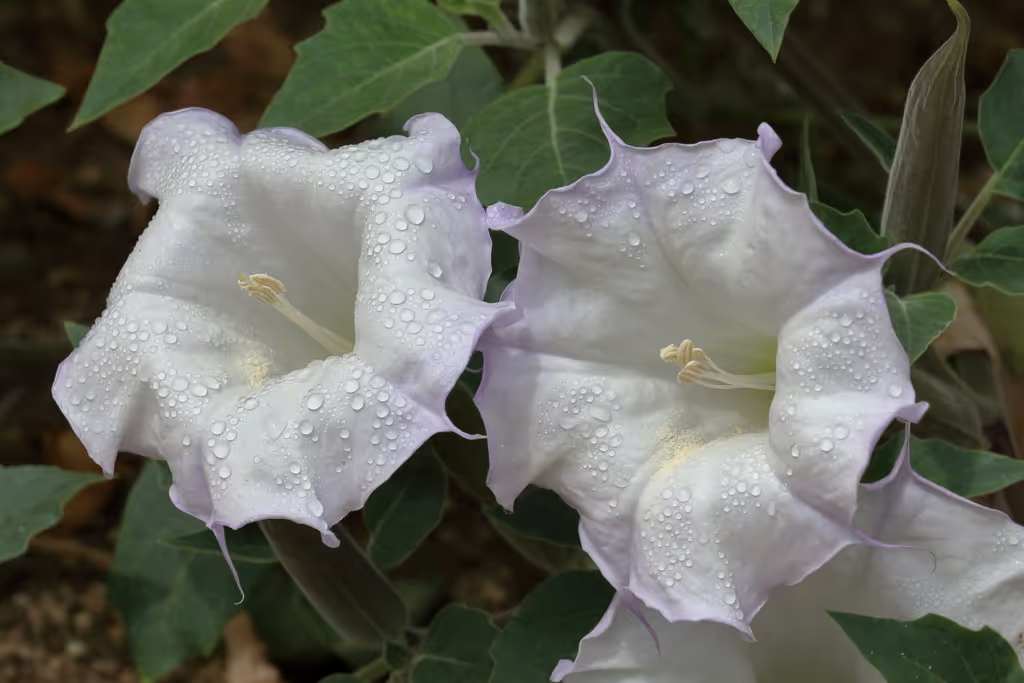
Sacred Datura
Datura wrightii
The enchanting sacred datura is a wildflower with broad, dark-green, wavy leaves and big, white, trumpet-shaped flowers. These flowers have 5 lines that radiate from the center of the flower, can have a slight purple tint, are sweetly fragrant, and are the highlight of the plant. Sacred datura can be found in gravelly open areas or alongside roads throughout the South-western U.S. It is also called sacred thorn-apple since its seeds are in spiky balls. Though this plant is dazzling, it is also dangerous; every part of this plant is quite poisonous. Because of its hallucinogenic properties, this plant is used historically by Native Americans for sacred ceremonies.

De la Mina Verbena (Lilac Verbena)
Verbena lilacina 'De La Mina'
De la Mina verbena, also known as purple Cedros Island verbena, is a beautiful shrub with green wrinkled leaves and fragrant, rich purple blossoms that grow in clusters on long stems. It only grows naturally on Cedros Island, off the coast of Baja California. However, it can grow in well-drained soils in South-western and Southern U.S. This lovely plant blooms almost year round, grows fast, and is drought tolerant.

Chuparosa
Justicia californica
Also known as beloperone, the vibrant chuperosa is a shrub with green, succulent-like leaves and lots of long, tubular flowers that come in different shades of red or sometimes yellow. Hardy and beautiful, chuparosa grows in hot, dry, and sandy or rocky places in Southern California, Arizona, and North-western Mexico. This plant also attracts a lot of hummingbirds and other birds. In fact, its name “chuparosa” meant “hummingbird” in Spanish!

Santa Cruz Island Buckwheat
Eriogonum arborescens
This extremely drought tolerant and elegant shrub has dark red bark, fuzzy, narrow leaves, and lovely clusters of frilly light pink or white flowers that brown as they age. Santa Cruz Island buckwheat only naturally grows on California’s Channel Islands, but has been planted on mainland California in sunny and well-drained areas. Like all buckwheat, Santa Cruz Island buckwheat is fire resistant. It also blooms almost year round and attracts lots of birds and butterflies.

Sulphur Buckwheat
Eriogonum umbellatum
Named after its striking yellow flowers, the sulphur buckwheat, or sulphur flower, is a small plant that has wooly, grey leaves and has its flowers in tall clusters. It is a tough plant, both drought and cold tolerant, and lives in a variety of habitats across Western North America. Sulphur buckwheat was used by Native Americans to soothe burns, for gynecological aid, and more. Its flowers also attract butterflies, including the White-Lined Sphinx moth, which you can see in our Butterfly Pavilion.

Island bush snapdragon
Gambelia speciosa
Vibrant and beautiful, the island snapdragon is a shrub with bright red, tubular flowers that grow in clusters and smooth, lime-green leaves. It prefers coastal areas, but is a drought-tolerant plant that can grow in well-drained and rocky areas. Hummingbirds love its lovely flowers, and island snapdragon is fire resistant. It is also an endangered species and only grows naturally on the islands off the coast of Southern California and Baja California.

Bladderpod
Peritoma arborea, Isomeris arborea
Bladderpod is a shrub with many branches, blue-green, circular leaves, and beautiful bright yellow flowers that grow in clusters. It tends to bloom year round and can be found from the coast to the deserts in Southern and Baja California. Named after its puffed up, edible seed pods, this hardy plant attracts hummingbirds, butterflies, and bees. It also gives off an interesting fragrance that is a source of debate: some think the smell is pleasant while others think the complete opposite. Visit the bladderpod today and discover what you think of it!

Western Columbine
Aquilegia formosa
Elegant with its bright red and yellow flowers, the Western Columbine is a beautiful addition to gardens. It is called by its scientific name Aquilegia formosa, which means “beautiful eagle,” since the flower’s shape resembles eagle talons, and this flower grows in moist, cool areas all across Western North America. Western Columbine is attractive to hummingbirds and has been eaten as a candy, used on bee stings, worn as a perfume, and more by Native American tribes.

Black Sage
Salvia mellifera
Common and beautiful, the black sage is a shrub with dark green leaves and mildly fragrant purple, blue, or white flowers that are in raised clusters. It quickly grows in sunny and dry areas, especially near the coast, from Central California to Baja California. It also provides food for bees, butterflies, hummingbirds, quail, and for us too! Black sage is famous for its honey. Sages are also famous for their medical properties; black sage has antimicrobial oils, is used to help with respiratory problems, is anti-inflammatory, and is used by Native Americans to treat arthritis.
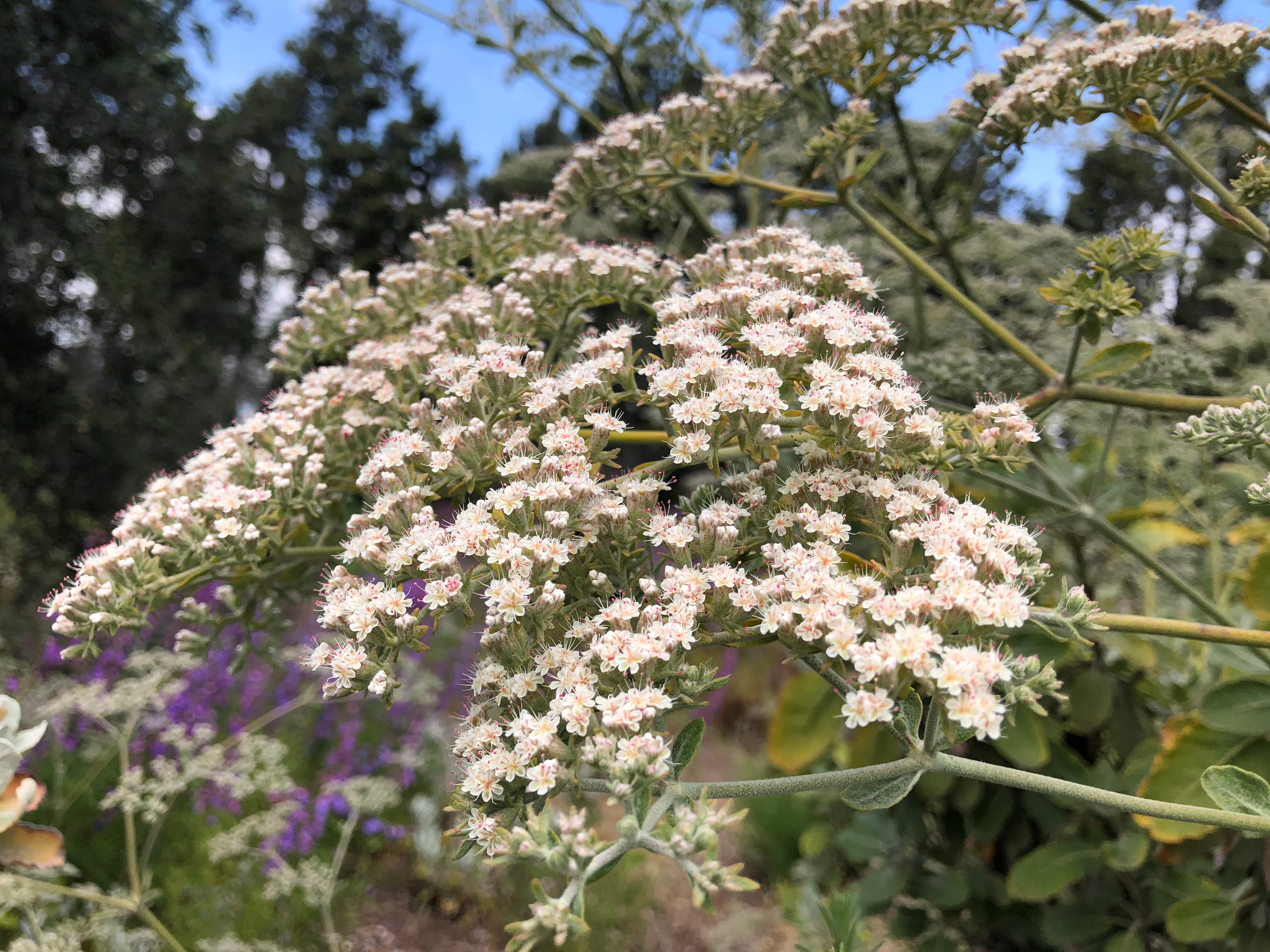
St. Catherine's Lace Buckwheat
Eriogonum giganteum
This elegant plant has “carpets” of tiny pink-white flowers that grow above its white-green leaves. It only naturally grows on California’s Channel Islands, in the fast-draining, moist, and rocky coastal scrub. St. Catherine’s Lace buckwheat is a very important food source for butterflies such as the Gray Hairstreak and for birds. In late summer and early fall its pinkish-white flowers get a new dark-orange color. This buckwheat has also traditionally been used by Native Americans to alleviate head and stomach aches.

California Brittlebush
Encelia californica
The California brittlebush is hardy and tall with bright yellow flowers that form in clusters on thin stems. They can grow in a variety of places, including rocky or marshy areas, throughout California and Baja California. This perky plant grows fast, loves the sun, and is perfect for bees and butterflies like the Painted Lady.

California Fuchsia
Epilobium canum, Zauschneria californica
California fuschia is well known for its vivid scarlet, four-petaled flowers and can be found growing abundantly on rocky hillsides or other well-drained areas. It only naturally grows in California. It is also known as Hummingbird Trumpet since it is very attractive for hummingbirds, and also for bees and butterflies/moths, like the White-Lined Sphinx moth that you can see in our Butterfly Pavilion. California fuschia is not only easy to grow, but it is also water wise, fire resistant, and was used by Native Americans to cure fever and infection and to promote overall wellness.

Desert Marigold
Baileya multiradiata
Desert marigold and their tall, radiant yellow flowers are perfect pops of color in gardens. They thrive in dry, sunny, and rocky areas in the southwestern parts of the U.S. and in northern Mexico. Desert marigolds are not true marigolds (Tagetes spp.) but both are members of the aster family (Asteraceae).
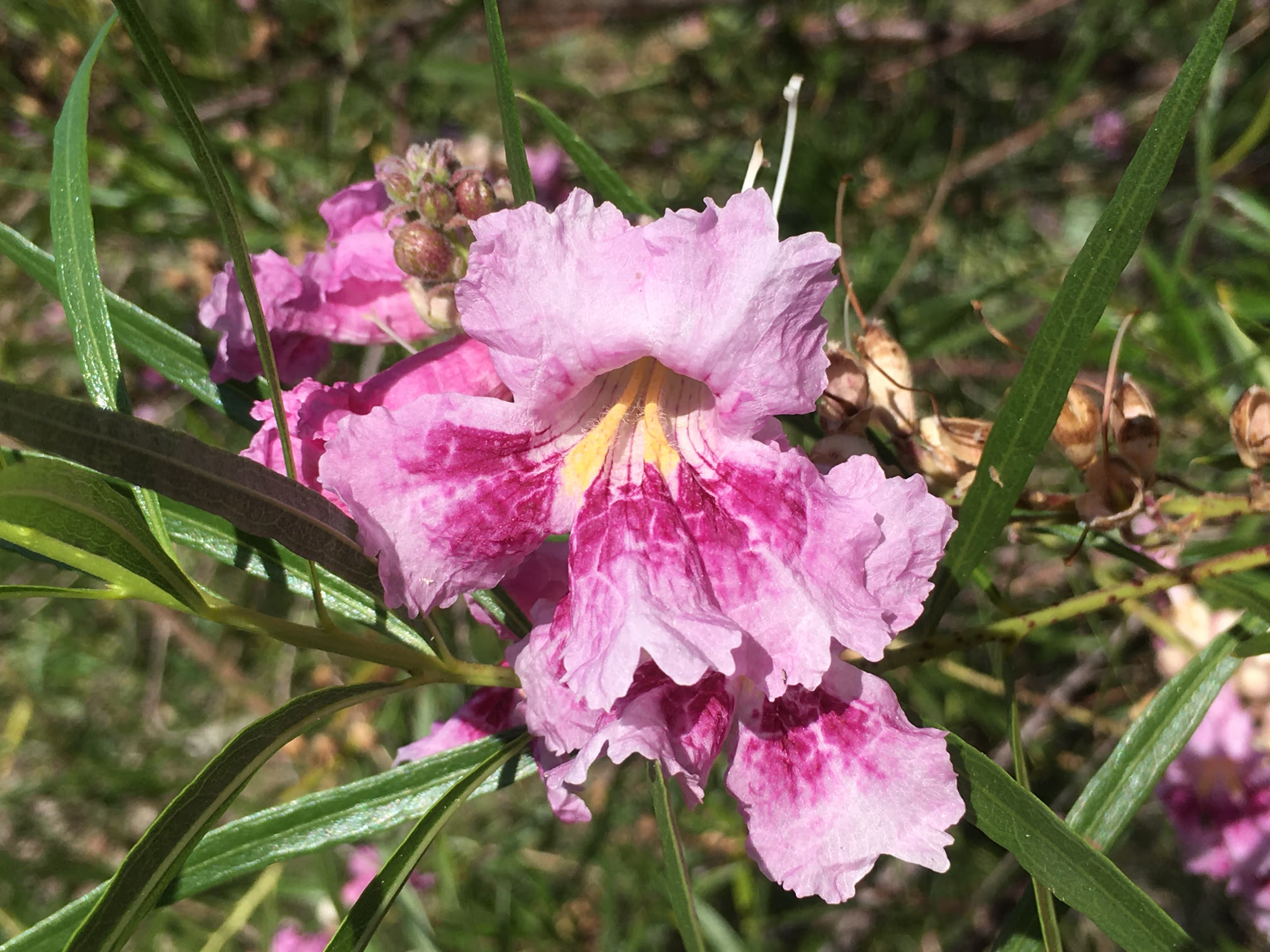
Desert Willow
Chilopsis linearis
Known for its durability and beautiful fragrant flowers, the Desert Willow is a tall shrub with long,green narrow leaves and pink or purple trumpet-like flowers. It grows in sandy areas and dry grasslands throughout the southwestern U.S. and Mexico. Desert willow is used in landscape design because of its beautiful flowers and nice form.

California Buckwheat
Eriogonum fasciculatum
This drought-tolerant and lovely shrub has small, fuzzy leaves and white, small flowers that grow in dense clusters on the bush. It can be found growing all over sandy areas, such as canyons and dried riverbeds, throughout Central and Southern California. California buckwheat’s beautiful flowers change color from white to pink to burnt orange as the plant dries and the season progresses, and has been used by Native American communities as a medicine to alleviate head and stomach aches, promote heart health, and aid in digestion.


















































